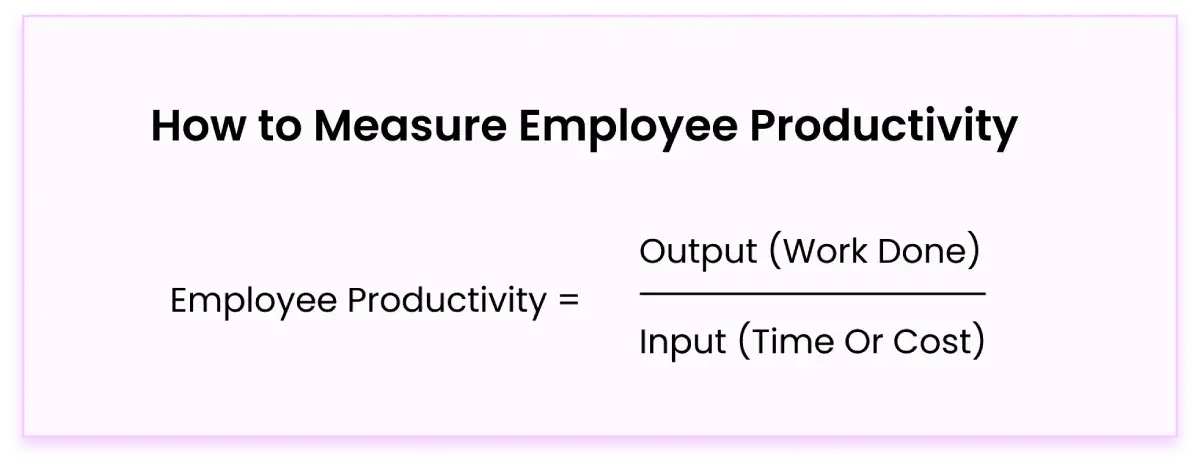Home / E / Employee Productivity
Employee Productivity: Meaning, Calculation & Improvement
Productivity from employees is an important measure for businesses to grow and succeed. When we think about productivity, we commonly think about how effective our people are in accomplishing a work output, as it contributes to our organizational objectives. Productivity means higher levels of performance, operational efficiencies, and greater profitability. For organizations in the modern workplace, increasing productivity is not just about getting people to work harder – it's about ensuring employees have the context, tools, and support to optimize their work performance.
Gallup estimates that teams at work that are engaged have higher profitability than disengaged teams. But productivity is more than a number. Productivity can vary from one organization to another, depending on factors like company culture, how the workspace is set up, employee motivation, and a healthy work-life balance. In this blog, we will provide you with the details for employee productivity – what is it? Why do we measure it? How do we improve it? What are the key challenges of productivity and trends that impact the workplace today?
What is Employee Productivity?
Employee productivity is the output an employee generates within a specific time frame compared to the input (time, energy, resources) to generate that output. Employee productivity defines how well an individual is completing their assigned work tasks, as well as contributing to organizational goals. Greater productivity typically aligns with greater efficiency and, therefore, greater output for the business.
Tracking employee productivity is more than about the numbers. Productivity tracking will reveal blind spots regarding employee performance, clarify bottleneck work processes, highlight areas of opportunity, and ultimately, assist HR teams and leaders to track available resources so that they can assess if they are spending time wisely and if team members are achieving results.
In a hybrid world, productivity tracking can provide clarity without micromanaging employees. Tracking productivity should ideally result in a culture of accountability and continuous improvement. On the contrary, productivity tracking can help organizations better align employee performance to organizational performance.
As well as having the ability to evaluate employee productivity to reward top performers and accountability for not performing as well (or requiring training or help), with consistent evaluations, organizational employee usage is a critical measure in achieving long-term growth for the business.
What Are the Factors Affecting Employee Productivity?
Not just the work environment, but employee productivity can be influenced or at least limited by the culture within the organization. The work culture of a company is defined in terms of perceptions, either positive or negative, that impact on the amount of work an employee can produce. Supporting an employee to have a productive environment, reasonable ergonomic workstations, some access to natural light, and the ability to work with little to no interruptions can increase employee focus and productivity. An organization providing a good work culture that defines itself as positive towards collaboration, recognizes team members, and cares for employees, can inspire motivation throughout the organization.
Employees who feel valued, respected, and are aligned with the values of the organization are more apt to remain engaged and committed to that work and have productive capacity. There may be some employees who are in a work situation that they feel disconnected from, experiencing burnout, and a lack of productivity. Organizations may be able to alleviate these situations by creating a healthy work environment designed to cultivate a positive culture, which is interconnected with a positive employee experience, productivity, etc.
How to Calculate Employee Productivity

Understanding productivity begins with accurate measurement. Here's how:
Formula for Employee Productivity:
Employee Productivity = Output (Work Done) / Input (Time or Cost)
Example Calculation:
Let’s say an employee writes 40 customer reports in a 40-hour week.
Productivity = 40 reports / 40 hours = 1 report per hour
If each report brings in revenue, you can also calculate revenue per employee:
Productivity = Revenue Generated / Number of Employees
For example:
If a sales team of 5 brings in ₹1,000,000 in a month, then:
Productivity = ₹1,000,000 / 5 = ₹200,000 per employee
How to Increase Employee Productivity in the Workplace

A positive work environment is one where employees feel that they are capable of doing their best work, and in doing that work, feel valued and engaged. Productivity at work depends on many factors, so it can look different for each person, team, and organization. Below are some ways to foster and grow employee productivity.
1. Set Clear and Realistic Goals
Get SMART goals (Specific, Measurable, Achievable, Relevant, Time-bound) so employees understand what their expectations are.
Objectives should be set as smaller milestones to maintain team focus and motivation.
89 percent of employees who are clear on their goals recognized increased productivity.
2. Promotion of Open and Lateral Communication
Encourage feedback, informal discussions, and open invite communication backup for manager/team conversations.
If your team uses regular stand-ups, continue to have productive talks early to address potential obstacles as they arise.
Employees who think their opinion matters at work are 4.6 times more likely to do their best.
3. Learning and Development as Investment
Put resources towards learning opportunities such as workshops, webinars, online courses, or a mentoring program.
Any company that invests in employee learning will have a 24% higher rate of productivity than less educated employees.
4. Use Timely Technology or Automation
Allow employees to experiment with the latest technologies and utilize productivity tools or provide the employee with the technology if needed.
36% of employees believe that artificial intelligence and automation technology increase productivity by decreasing the time spent on mundane or irrelevant tasks.
5. Support a Better Workplace
Provide workspaces that are comfortable and adaptable so all employees can focus on their work and cooperate.
Recognize and celebrate achievements and rewards, valued employees may be productive up to 50% more.
What Are the Common Challenges of Employee Productivity?
Organizations continually run into challenges with productivity; more often than not, employees are missing true productivity by not using the processes and protocols as intended to facilitate productivity.
Without clarity around goals, objectives, and a directive for the work itself, the employee is bound to waste some of their efforts pursuing tasks not valuable to meaningfully.
Ineffective communication, accompanied by a lack of clarity, will lead to mistakes, thus extra work and duplication of activity resulting from a lack of clear direction.
What Are the Latest Trends in Employee Productivity?
Being current can contribute to organizational agility and competitiveness. There are a few trends to be aware of:
- AI and Automation: AI tools can help eliminate repetitive work and provide time for strategic work.
- Flexible and Remote Work: Organizations are introducing flexibility to work (which arguably increases focus and morale).
- Data-Driven Decisions and Management: Organizations are integrating more analytics to support assessing trends and productivity, to then adapt work and workflows in a better way.
- Mental Wellness: More organizations are showing interest in programming that promotes wellness because businesses are realizing the connection between productivity and wellness.

